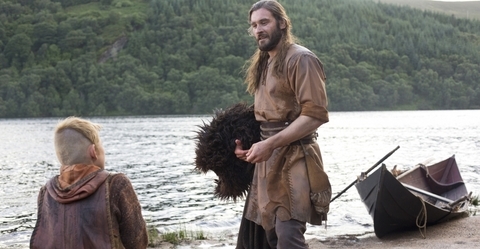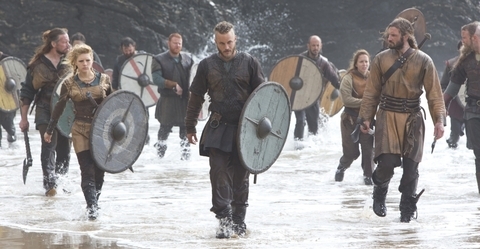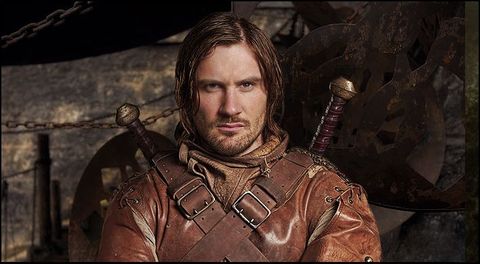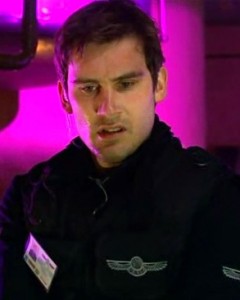The Light from the TV Shows: A Chat with Clive Standen (“Vikings”)
Given the astounding success that History Channel found with its previous based-on-stuff-that-really-happened dramatic effort, “Hatfields and McCoys,” it’s no wonder that the network is throwing such a profound promotional push behind its latest endeavor, “Vikings.” Granted, the cast of this one can’t quite compare with headline names like Kevin Costner and Bill Paxton, but don’t be so hasty to dismiss it just because you don’t know as many of the actors off the top of your head. After all, at the very least, it’s got Gabriel Byrne, who’s quite good (as anyone who’s watched him on HBO’s “In Treatment” or any number of his many cinematic efforts can handily testify), but, seriously, there’s a lot of other solid actors in the ensemble as well…like, say, Clive Standen, for instance. Bullz-Eye had a chance to chat with Standen about his work on “Vikings,” but we also managed to chat a bit about his work on “Camelot” and “Doctor Who“ as well as a slightly less fondly remembered effort called “Heroes and Villains.”

Bullz-Eye: To start with the inevitable, how did you find your way into “Vikings“ in the first place? Presumably it didn’t hurt that you’d already worked with the creators.
Clive Standen: It was a long process for me. I was fighting them, kicking and screaming, to try and get seen for this. [Laughs.] I was filming with one of the producers of Vikings, Morgan O’Sullivan, when I did “Camelot,” and I remember him and Michael Hirst talking about it quite a lot then as a new, exciting project they’d been working on for ages. Michael had been invested in the Viking saga for a long time. Right from the beginning, I think they were looking for big names, and they had their kind of wish list, with people like Viggo Mortensen and…well, it was a completely different breed. And I was stuck in “Camelot,” and I was just so jealous. When “Camelot” was finished, I was writing letters and, as I say, kicking and screaming, saying, “Can I get seen for it?” And they wanted to see me for Rollo, which is the part that I played, but for some reason I went on this whole journey of doing screen tests and things for the part of Ragnar. At the very end, though, they offered me Rollo, which was the part that I wanted in the first place, so I must say it made me very happy.
BE: So how much knowledge of the Vikings did you have before coming onto the project?
CS: Well, I’m one of those kids that was brought up by… My parents in England used to take me to every castle and thing imaginable. I was climbing around the countryside, climbing around castles with my older brother from an early age. So I’d kind of been brought up on a lot of the history and things, so I’ve always been mad about Vikings. Or anything from the Medieval era, really. But just like I think a lot of the general public will be before they see “Vikings,” I thought I kind of had it all worked out. It’s only since working with Michael Hirst on “Vikings” that you realize that there’s so much more to the Scandinavian saga and their way of life than you’ve ever imagined. Most of the things we think we know about Vikings has all been written down by the Christians, and it was the Victorians that kind of created this whole Vikings with big-horned helmets thing. There’s a lot of things written down, descriptions of these frightening Norsemen who came from the sea, with horned helmets sent from the devil himself… [Laughs.] It’s this very one-dimensional view of this massive civilization of people. But Michael Hirst, what he’s done is, he’s gone and looked at it from the inside out and really invested the time, actually going to Scandinavia and researching all the sagas and the history behind it. This’ll be the first time ever, I think, where the Vikings will be the heroes. They did do the plundering, they did do the ransacking and the colonizing, but when you look at it from their point of view and the reasons why they did that, the gods they believed in and the society they lived in, you’ll have a completely different vision of the Vikings than you think you know today.

BE: Is there any particular factoid that you learned during the course of production that really surprised you?
CS: Oh, don’t start me! I can tell you everything about how they used to get moss from the volcanic mountains in Iceland, and they would get the steel out of that, and they’d put it into kilns and get the steel to create the swords that they used. Seriously, I could go on and on and on. I can get really boring when I get talking and start going on about Vikings! [Laughs.] But there’s all sorts of stuff. They were very clean, and they used to…it was when they came over that the Saxons would actually adopt a lot of their intricate hairstyles and haircuts and things. We kind of believe that Vikings were these dirty scumbags that used to never wash and fart and spit, but it was quite the opposite. The Vikings, the Scandinavians, were responsible for bringing a lot of the fashion and the style that the Saxons ended up adopting.
BE: Hairstyles, fashion…maybe this is less of a “guy’s show” that one might think.
CS: [Laughs.] Oh, no, no, no. But I could go on and on and on with factoids about these people. The thing about Vikings, they were scientists and explorers, and they unfortunately didn’t write a lot of things down, but…they were astronomers as well, they learned how to read the stars, they learned how to read the weather, and to navigate across the open oceans. There were things that made them the Leonardo da Vincis of their day. There’s lots of things. They were a very civilized society. They were a very simple people, and they had a big rule system. You’ll see in Episode 1 that we go to the Althing, which is kind of where the word “thing” comes from. It was kind of an all-encompassing courtroom where they would sort out their problems from different tribes and different neighborhoods from all around Scandinavia. You’ll see in Episode 1 where we have someone who’s stolen someone and there’s a quarrel between people, and if they’d walked past the third house without reporting it, then it’s suddenly a misdemeanor. There was a big civilized society behind all this.

BE: Some viewers may be surprised that Katheryn Winnick’s character is a formidable fighter in her own right.
CS: She is, yeah! Yeah, me and Katheryn had a lot to do, ‘cause I used to be an international Thai boxer, and Katheryn did lots of taekwondo, so we had a lot to talk about…and we got to spar a bit between takes! [Laughs.]
BE: Your scenes were predominantly with Travis Fimmel, though, correct?
CS: Yeah. Travis is a formidable actor to work with. He’s really organic, which is a lot of fun. He’s also a massive practical joker as well. He keeps it in check, but then he keeps us all entertained as well.
BE:How much interaction did you have with Gabriel Byrne?
CS: Ah, Gabriel’s great. I have a lot of scenes with Gabriel. Gabriel is a very, very giving actor, and it’s very nice to have him on set and be that sort of stalwart that he is. Because he’s very good at calming everyone’s nerves down. He makes it easy for you to come up on set and act with him. He doesn’t hold any bravado at all. He’s a very, very lovely man. And a great actor. He plays Haraldson right down to a tee.
BE: You’re obviously no stranger to period pieces, but what was the Viking attire like for you?
CS: Ah, the Viking attire… Well, we’ve got this brilliant costume designer, Joan Bergin, and she’ll design what you have to wear, and she’ll do it with you as well, so you have a nice input into it. When it comes to the fighting styles and what you need to do with your character, the costume…you have to have a quite collaborative say in what you wear and how it can help you every day in life as a Viking, as Rollo. But the costumes are fantastic. They would just constantly be making new costumes, and we’d have this massive array of different stuff, from leathers to cotton to whatever fabric. It was just phenomenal. The costume department, they often don’t get enough recognition. A lot of the costumes that get recognition are the beautiful, elegant costumes like you see in “The Tudors” and “The Borgias“ and things, but there’s a lot of work that actually goes down into beating down and aging some of these costumes to make them look authentic. Some of the costumes that we have…they’re really phenomenal.

BE: In regards to one of those other period pieces I mentioned, what was the experience of “Camelot” like for you?
CS: “Camelot” was…well, see, “Camelot” was great, but it’s a very different story. Because, y’know, the story of King Arthur, it’s been done to death, and I think everybody thinks that they know who King Arthur and Guinevere and Lancelot are. But “Camelot“ was a completely different…it was more just pure escapism TV. It was grand in scale, but it didn’t really delve into the historical accuracies that “Vikings” goes into. Michael comes from this background where I think that History is the perfect channel to have “Vikings” on. They’ve been at it for a long time, building an audience that are interested in the documentaries that they make, and what they’ve been able to do is…there’s now room for the scripted genre, where they creative this massive visceral, epic landscape and epic story while also kind of keeping it very much immersed in the historical accuracy that its viewers are used to. They’ve created a niche in the market.
BE: Had there been any talk of where the series would have gone if it had gotten a second season?
(Writer’s note: As you are about to see, due to a dodgy connection on the line, Standen misunderstood this question—I was actually still talking about “Camelot”—and thought I was asking about the future of “Vikings.”)
CS: Well, Michael has a massive, massive vision for “Vikings.” I mean, I was lucky enough…me and Travis got to read what he calls the “Viking” Bible, in which he’s planned out many seasons. Really, Season 1 is just the tip of the iceberg of what we can offer. There are so many great characters in some of these sagas, y’know? There’s so much more to come. Even Alfred the Great himself, who kind of defeated the Vikings in the end in England. But they go to Iceland, and there’s Leif Erikson, who travels across the Atlantic. There’s so much more to come, and Michael…if you sit down and talk to Michael, he can go on and on and on about all the ideas he’s got. There’s just a plethora of stories we can tell. It’s just the tip of the iceberg in Series One. But everyone’s based on real historical figures. Ragnar Lothbrok was the original true Viking who you see rise to fame. He was called Hairy Trousers. [Laughs.] There’s lots of tales about him. But Rollo, the character I play, is actually the great, great, great, great, great grandfather of William the Conqueror, the Duke of Normandy, and he was responsible for sacking Normandy and going to France.

BE: I know we need to start wrapping up, but I wonder if you could speak briefly about your experiences on “Doctor Who.”
CS: On “Doctor Who”? I loved “Doctor Who”! [Laughs.] It’s very, very close to my heart. They were very good to me, the guys on “Doctor Who,” and…I’m a bit of a geek at heart. I love a bit of sci-fi. And it was great to be a part of “Doctor Who,” ’cause in Britain, anyway, but I’m sure in other countries as well, it’s one of the more cherished crown jewels in the sci-fi TV world. Yeah, I had a lot of fun doing “Doctor Who.” And I got to work with David Tennant, who I think is my favorite Doctor.
BE: Were you surprised when you got the callback to do the episode “Turn Left” later in Season Four?
CS: Yeah! But it was great to have that scene, particularly to announce that the Doctor was dead. Even though it was really only just that one scene in “Turn Left,” there was a lot of weight on my shoulders to get that scene right. Russell T. Davies was actually going, “Uh, yeah, this is quite an important scene, so you’ve got to get it.” But it was a lot of fun. Russell was really good to me.
BE: Lastly, have you got anything to say about working on your first film, “Heroes and Villains”?
CS: “Heroes and Villains.” That was, uh… [Nervous laugh.] That was an experience. I think when you come out of drama school, you take jobs and you do stuff. I only had a very small part in “Heroes and Villains,” but…y’know how you have some things that you’re proud of, some things that you’re glad you did, and everything happens for a reason, but it’s, uh, not one of the crowning moments in my career, that one!
BE: Well, we won’t leave it on that, then. I’ll just close by saying that I’ll keep my fingers crossed that “Vikings” does as well for History Channel as “Hatfields and McCoys” did.
CS: Oh, I hope so. I mean, the one endorsement I can give it is that it’s one of the first things I’ve done in a very long time where, regardless of if I was in it or not, I’d still just love to watch it. It’s something I’m very proud of, and it’s something I think has never been done before, so I’m hoping it finds a place in the marketplace. I mean, it’s a show that’s must-watch event TV. It really is.








